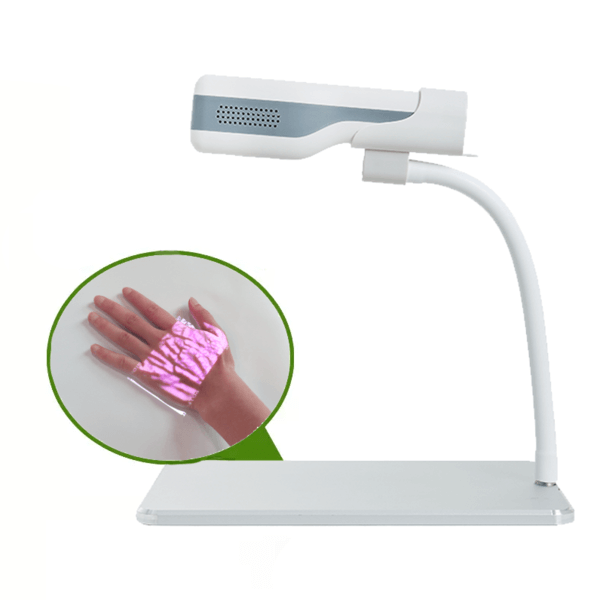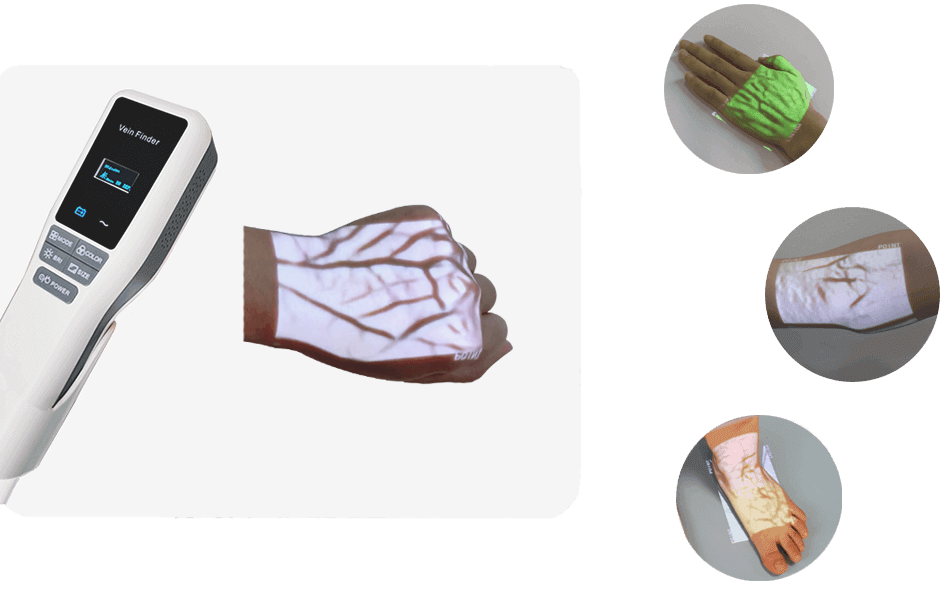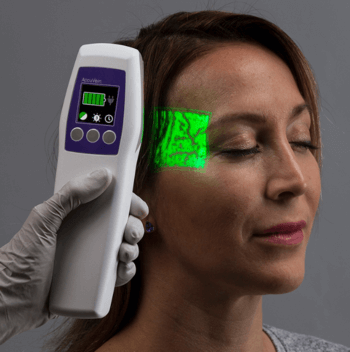A
near-infrared vein finder is a medical device that uses near-infrared light to highlight veins under the skin, making them easier to locate for medical procedures such as blood draws or IV insertions. The device illuminates the skin with near-infrared light, which is absorbed by the blood in the veins and appears as a contrasting image on the surface of the skin. This technology can help medical professionals to quickly and accurately locate veins, reduce patient discomfort, and improve the success rate of procedures.

What is near-infrared light?
Infrared light (IR) is light that is just beyond what the human eye can see. Near-Infrared Light (NIR) is the part of electromagnetic radiation (EMR) wavelengths closest to what we can see but just beyond it. The smallest part of the electromagnetic (EM) radiation field is the light we can see. Electromagnetic energy is all around us every day. It comes from radios, TVs, microwave ovens, the sun, X-rays, and for some,
gamma rays. Then, this infrared spectrum is split into near, middle, and far.
What are vein finders?
Vein finders are medical devices that work on the premise of varying light absorption rates in Blood and surrounding tissue. As a result, it can
display veins in real-time, allowing medical personnel such as nurses and doctors to detect veins and perform various procedures more rapidly and efficiently.

How does a near-infrared vein finder work?
NIR light goes deeper into tissues than visible light, and veinous Blood absorbs it differently than soft tissue around it. The device shines near-infrared (NIR) light into the patient and collects the light that bounces back. This lets the device show a picture of the veins. Clinicians can use the image to find veins they couldn't find using typical methods. Clinicians can also use the device to check veins, both those found with traditional methods and those that can't, to see if they are suitable for
vascular access.
Is it safe to use near infrared vein finders?
A
harmless form of light, infrared is perfectly fine to use. The human eye and body are unharmed by infrared or near-infrared light. Health advantages from red light treatment devices like saunas are attributed to both near-infrared and far-infrared wavelengths of light.
Near infrared vein finder uses:

Near-infrared (NIR) vein finders find veins that can be used for vascular access procedures, like taking blood samples or getting ready for an
IV drug infusion, without hurting the patient. The devices can be used in all areas of patient care where vascular access procedures are done. They can be used on all patients, especially those who have trouble getting an IV started, like newborns, children, the elderly, people who are morbidly obese, people with dark skin, or people with diabetes. NIR vein finders, called NIR light, use light that can't be seen.
1) Inserting an IVThis is the most important way to use a vein finder. Setting up an
intravenous (IV) line is one of the essential skills many medical professionals have trouble with. This hurts the patients more than it needs to. We've all feared that the nurse would stick the needle in, but there won't be any blood flow, so we'll have to do it again. And for people who have trouble getting their veins to work. Patients who are old, overweight, have dark skin, have used IV drugs in the past, have low blood volume, or have a long-term illness make it harder to find a vein.
2) For Drawing Blood Though there is no substitute for the experience of a qualified practitioner, the vein finder can help simplify the procedure of determining the spot of needle placement. Because different body areas do not limit the
vein visualization principle, it may be utilized for blood draw procedures. It performs well for the median cubital vein because it is a huge conduit. The vein finder may always clearly show the median cubital vein. Vein finders can be helpful, especially for people with limited experience.
3) Cosmetic Surgery Some people may be unaware that doctors must avoid veins when performing cosmetic procedures such as injecting fillers, particularly inside the tear through nasolabial folds and lips. If you unknowingly inject the filler into the blood vessels, not only will your face be messed up, but so will your life and the
surgeon's career.
Types of infrared vein finders:
1)
Vein finder with Infrared projected light: Projected Vein Finder is currently the most common vein finder because it is light and easy to use. But what makes the Infrared light Projected Vein Finder so popular is that it can show images of veins right on the patient's skin. It is very easy to use every day. Most of them come with a stand or support, so you don't need someone else to hold them. You can just put it on a desk and use it daily.
2) Vein Finder with Infrared Light Screen: Infrared light Display Screen Vein Finder means that when the device takes a picture of a vein, the image appears on a screen. A probe and a screen are always included with the device.

USE HELLOVEIN FOR THE BEST EXPERIENCE
Every day, 40 million vein punctures are performed worldwide, with 20% of adults failing on the first attempt and 33% failing on the first attempt with newborns and children. Finding a vein is vital when the patient is very unwell, and the illness can be passed on to the healthcare professional. The
Hellovein vein finder is highly portable and light. It is intended to be transported from room to room in a hospital, into the home for home healthcare, and to outlying towns and villages.

Conclusion
The
HelloVein vein viewer uses advanced two-dimensional digital contrast technology to project a clear image of vascular mapping right onto the skin. Using that image, doctors and nurses can find a vein to stick to and improve their success rate to as high as 100% on the first try.
HelloVein's images are so clear that the staff can also see the structure of the veins and where they are located, the veins' branches and blood flow. In the end, this highly effective and easy-to-use vein detection device helps staff do their jobs better and makes patients happier.




